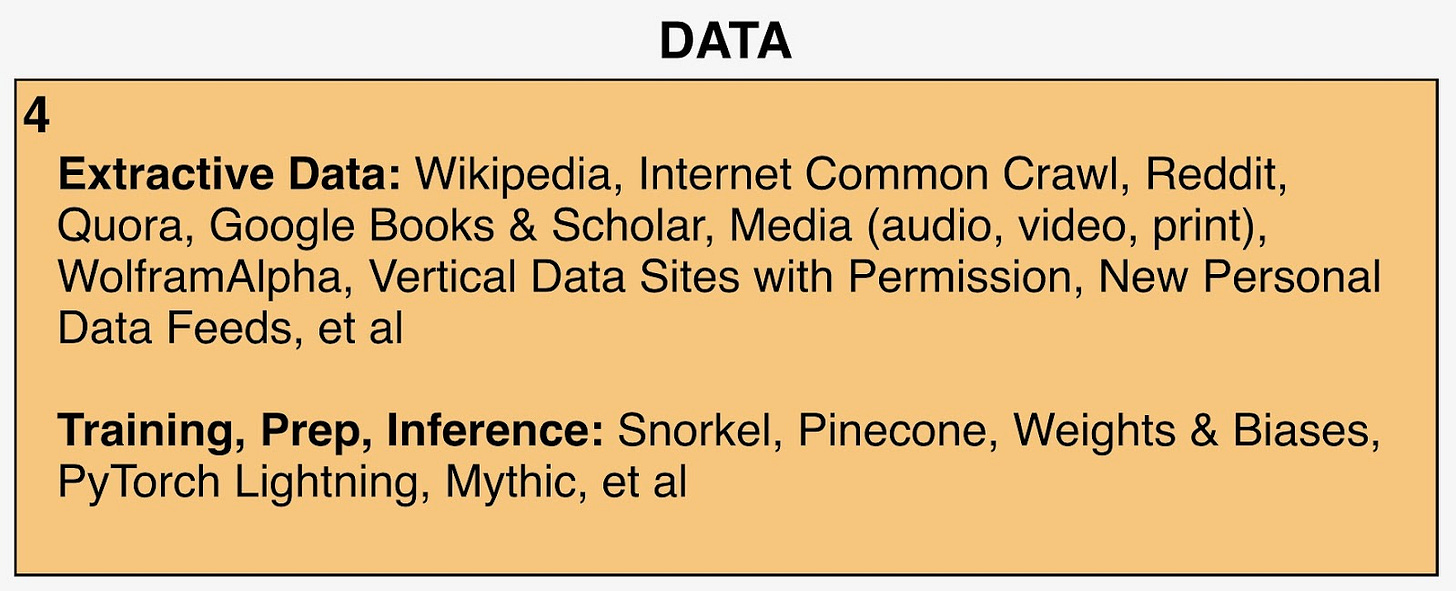AI: Data and Copyrights
... tussles ahead
The last few posts emphasized how the emerging AI Tech Value Stack is building new value in similar, but different ways than the PC and Internet waves, and the critical role that Data plays in the AI Tech Value Stack
And showed how Google’s YouTube videos, and other video sources could be a new source of Data for Foundation LLM AI models to train in and provide exponentially better AI results to users worldwide.
And how the Data all the models are using right now are but ‘a tip of the tip of the iceberg’.
But there’s one obvious issue that companies large and small are going to have to navigate before it’s clear sailing in AI land. And that of course, is the issue of IP and copyrights.
Since all the Data items in Box 4 below are the raw source material to train hundreds and soon thousands of LLM AI models worldwide, and much of that data is material that has IP and copyrights under a different digital world, the question of “Fair Use” and potential copyrights of course comes up. Get ready for some epic tussles.
We’ve seen this movie before of course when Napster in 1999, made the world’s music available for ‘free’ for a while. And it felt ‘magical’ for users then, users today are enchanted with ChatGPT and other AI services today. And there’s a Gold Rush for today’s AI companies large and small, to leverage all available text, audio, music, video and other published content, to generate their ‘magical’ AI results.
Let’s start with the Music industry which is still climbing back from the heights of almost $40 billion in 2000 to $26 billion today, almost 23 years later. As this week’s Barron’s article outlines:
“AI is dangerous to existing industry players, and appears to be weighing on their stocks, because it can divert money away from musicians and music labels and toward people using technology to mimic them.”
“The recorded-music industry pulled in $26.2 billion last year, less than two-thirds its 1999 revenue in inflation-adjusted terms, even as music has become more accessible than ever.”
As the article outlines, the three companies that dominate Music worldwide, Universal, Warner and Sony, are laser focused on working with the Tech companies to make sure their artists are compensated somehow from the AI usage bonanza to come.
Even as the Copyright Office is still figuring out how to deal with this technology, as they had to do over decades with other technologies. The issues range from Music, Images, Videos, Code, and far beyond.
As this Information piece notes how the global leader in Images, Adobe is dealing with AI, in this period of immense AI innovation,
“Adobe wants to be the white knight of the AI wars, standing in contrast to Stability AI’s Stable Diffusion, OpenAI’s Dall-E 2 and Midjourney, all of which scraped millions of images across the internet to train their models, disregarding the copyright laws meant to protect artists and their work.”
But as the piece goes on to explain, even Adobe may not be on solid footing, since they’re mining the images Data from its huge stock library of images, licensed from artists over years, when AI was not at all in the picture.
We are going to see the same tussles in video and other types of Data. Lawyers and Courts are going to be very busy for years, just as they were in prior Tech waves. This time though, there are arguably new precedents to be set, given the fundamentally novel ways that the AI technologies work.
The good news is that industries and companies at large, have seen how these issues can be navigated from prior Tech waves.
We’re way past Napster, and have seen how YouTube, Spotify, TikTok and so many others can be a large source of revenues for copyright and IP owners. And regulators worldwide are also focused on the issues to help mediate, regulate, and potentially legislate. Industries and stakeholders globally are now forewarned, and forearmed.
Now most everyone knows by now that it’s just business. The tussles are a prelude to negotiations and arrangements. So deals will be struck. Will have more on all this in future posts. Stay tuned.




